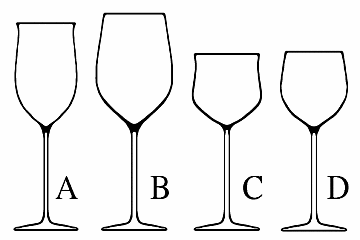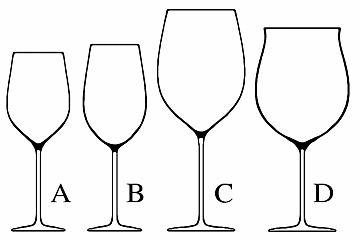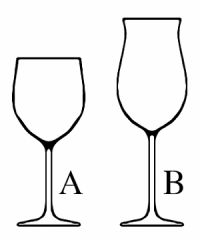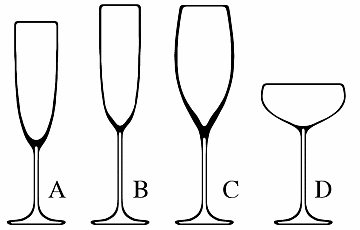The
Proper Wine Glass

How to choose a Glass
| Every wine
has certain organoleptic characteristics which are different from any
other. For this
reason, every wine should be served in a proper glass capable of
exalting its characteristics. Wine glasses come in different shapes and
characteristics, sometimes considered as extreme because of some
producers who tend to make specific shapes and styles, not only for
certain wines, but also for specific wines made of certain grapes or
coming from certain areas. The shape of glass helps a wine to
express better and every glass usually is the result of specific studies
and researches, both on the organoleptic perception of aromas and
flavors, as well as on characteristics and physical conditions that
favor their perception. One of the fundamental characteristics for a good
wine glass is that it must allow the proper appreciation of wine's
aspect, therefore it must be colorless, transparent, with no decorations
or facets. Wine glass must preferably be made of crystal, however
half-crystal or superior glass are more than acceptable. No matter the
kind of material glasses are made of, crystal or superior glass, it is
important for them to be thin, possibly less than one millimeter. A
greater thickness, besides being unpleasing when in contact with lips,
would influence the perception of some tactile sensations. Wine glasses should always have the typical
stemware shape, a sufficiently large base in order to keep them
vertically stable, a long stem and the shape of body capable of exalting
each style of wine. The importance of these characteristics being
present in a wine glass is essential because they allow to appreciate a
wine better and to alter it the least possible. A long stem avoids, for
example, the hand to be in proximity of the body of glass with the risk
of altering the temperature of wine as well as being closer to the nose
and therefore influencing the perception of aromas. For this reason wine
glass must always be held to the base, or at least to the lower part of
the stem, never to the body. Lastly it should be remembered a glass must
be filled no more than one third of its total volume. |
Glasses for White and Rose
Wines
Here
are some types/shapes of glasses suitable for the service of white and
rose wines.
Young and Crisp White Wines (A) - The
main characteristic of this glass is the shape of the opening which tends
to enlarge in respect of the body. When a wine is introduced in the mouth,
this particular shape directs the liquid mainly to the tip of the tongue,
more sensitive to sweetness, and therefore to the sides of the tongue,
more sensitive to acidity. This glass is also suitable for young and crisp
wines having a certain quantity of residual sugars that should be
emphasized. The shape of the glass also allows the concentration of aromas
towards the nose while emphasizing the perception of delicate and fruit
aromas of young wines. Young and Crisp Rose Wines (C) - In this kind
of glass are valid all the considerations expressed for young white wines'
glass; the enlarged opening directs the wine to the tip of the tongue,
more sensitive to sweetness, in order to make the wine appear more
balanced. Another characteristic of this glass is the large body which
allows an adequate oxygenation and therefore a correct development of
aromas. Bodied and Mature Rose Wines (D) - In this
kind of glass are valid the considerations expressed for structured and
mature white wines. The larger shape of the body allows an adequate
oxygenation of wine as well as the development of aromas. |
||||||||
Glasses for Red Wines
Here
are some types of glasses suitable for the service of red wines.
Young Red Wines (A) - This glass is
fundamentally the same used for bodied and mature white wines, as a matter
of fact it can be used the very same glass. This kind of wine, having
rather aggressive tannins, when present, must mainly stimulate the inner
parts of the mouth while avoiding, at least in the initial phase as the
wine is introduced in the oral cavity, the contact with gum because the
astringency would originate an unpleasing tactile sensation. The body of
the glass must also be large in order to allow an adequate oxygenation and
development of aromas. Full Bodied and Very Mature Red Wines (C) -
The characteristic of this glass is its large size, with a rather wide
body in order to allow a proper oxygenation of red wines aged for a long
time in bottle and with tannins that reached a milder and rounder state.
The wide shape of this glass also allows to avoid, when possible, the
decanting of wine, thanks to its width it makes possible a proper
oxygenation of wine while developing complex and tertiary aromas which
will be concentrated towards the narrow opening. Moreover, the opening is
tall and straight in order to direct the wine to the back of the mouth,
exactly for the very same reason applied to every other glass for red
wines. Because of its characteristics, this glass is to be used for wines
produced with very robust grapes such as Sangiovese or Cabernet Sauvignon.
Full Bodied and Very Mature Red Wines (D) -
This glass represents a variant of the previous one and the difference is
to be found in its opening which tends to enlarge. This characteristic
directs the wine towards the tip of the tongue, more sensitive to
sweetness, and is useful for those wines that after a long time of aging
tend to exalt their acid component, such as Pinot Noir or Nebbiolo. |
||||||||
Glasses for Sweet and
Fortified Wines
Here
are some types of glasses suitable for the service of sweet and fortified
wines.
Sweet Wines (A) - This glass has little size
having a wide body and a narrow opening in order to exalt both the
development of aromas and their concentration to the nose. The reduced
size suggests the service of a tiny quantity of wine which is also a
common habit for these kind of wines. The straight opening allows the wine
to be directed towards the back of the oral cavity in order not to
excessively exalt the sweetness and therefore avoiding the wine to appear
sickly. |
||||||||
Glasses for Sparkling Wines
Here
are some types of glasses suitable for the service of sparkling wines.
Classic Method Wines (B) - This glass, called
flūte, has a narrow and tall body in order to favor and appreciate
the development of the refined perlage typical for this sparkling
wines produced with the classic method. Its narrow diameter also promotes
the perception of fresh and delicate aromas, therefore this kind of glass
is suitable for young and non vintage classic method sparkling wines. Mature and Vintage Classic Method Wines (C) -
This is a flūte having a larger body and narrow opening,
characteristics which allow the oxygenation of wine and therefore a proper
development of complex and tertiary aromas of the mature and vintage
classic method sparkling wines, without compromising the development and
the appreciation of perlage. Aromatic Sweet Wines (D) - This glass, simply
called cup, is particularly suited for aromatic and sweet sparkling
wines, such as Asti Spumante. Because of the aromatic richness of these
wines, it is better to serve them is glasses having very large opening,
instead of flūte, in order to mitigate the aromatic strength of
the grape while allowing other aromas to develop. These sparkling wines,
usually produced with the Charmat method, does not have any
particular qualities of finesse in the perlage, therefore this is a
factor that can be neglected. The opening of the glass, which slightly
tends to narrow, will direct the wine to the tip of the tongue in order to
exalt wine's sweetness. |
||||||||

Information and tips for finding end enjoying everyday wines from Europe and other major wine regions:
Search the Blogs
Copyright WineNews.com 2009





